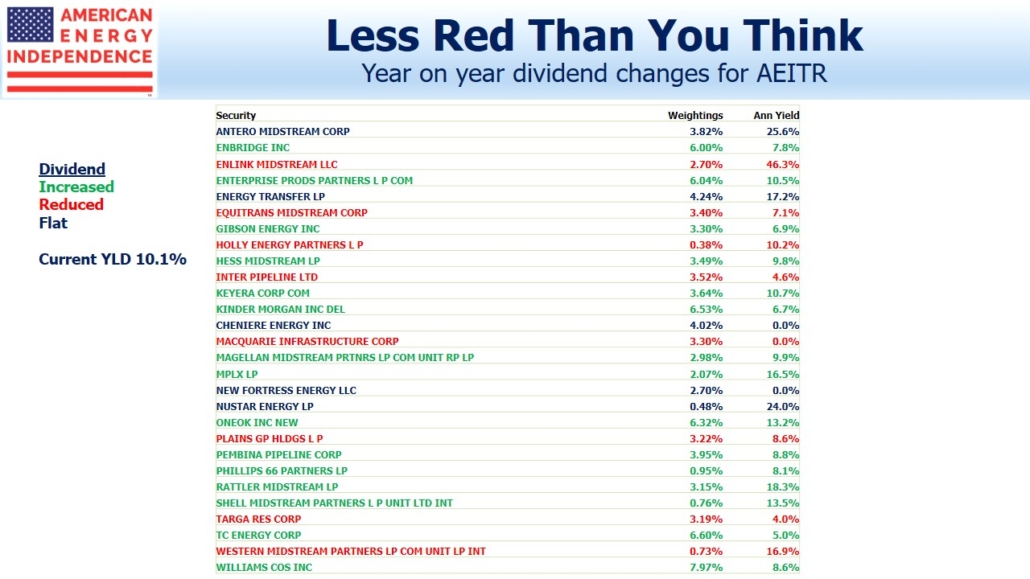Most companies get a free pass today on cutting their dividend. So far this month nine S&P500 companies have suspended their dividend, with another half dozen making reductions. Goldman Sachs expects S&P500 dividends to be reduced by 25%.
Energy has been hit as much as any sector. Pipeline stocks have fallen hard, with the broad-based American Energy Independence Index (AEITR) down 36% for the year. It has rebounded strongly in April, up 35% so far this month.
Part of the reason is that the dividend story is turning out to be much less bleak than expected. Most big companies have provided updates, and so far only eight have reduced dividends. Only one of those (Macquarie Infrastructure) has suspended its payout. Using their weighting in the AEITR, 20% of the index has lowered dividends.

A pleasant surprise is that 13 companies still pay dividends that are higher than a year ago, representing 64% of the index. This group includes some big names, such as Enbridge, Kinder Morgan (KMI) and Williams Companies (WMB). Some of these have yet to declare a “post-Coronavirus collapse” dividend, but we think those planning to cut have already communicated. KMI had originally planned to increase their dividend by 25%. The fact that they raised it at all last week was welcome news to many investors. The week before, WMB had said they expected to fund this year’s dividend payments and growth spending from internally generated cash.
Most energy infrastructure companies providing updates have reaffirmed prior guidance or lowered it modestly. All have lowered their planned spending on growth projects, and generally the spending reductions are bigger than any forecast drop in EBITDA. Although the rest of the year is too uncertain to make any confident forecasts, a dollar not spent is a dollar of Free Cash Flow (FCF). Prior to coronavirus, we were looking for FCF to double this year (see Updating the Coming Pipeline Cash Gusher) . Lower spending was a key reason, and 20% cuts are common.
Dividend hikes in this environment are surprising. We’re all enduring a crash course in epidemiology, but it’s fair to say that the companies maintaining and raising their dividends are comfortable that these are sustainable based on consensus forecasts of the economic rebound from the Coronavirus. The yield on the AEITR is 10%.
MLPs are only about a third of the pipeline sector. Only two of the ten biggest companies are MLPs — Energy Transfer and Enterprise Products. Magellan Midstream is another well-run MLP that’s just outside the top ten. But the rest tend to be smaller and more oil focused, with weaker balance sheets and more gathering and processing exposure. This is why 17 MLPs had cut distributions as of last Friday, according to Hinds Howard at CBRE Clarion Securities. Yesterday on Twitter he noted the figure had reached 21.
The bottom line is that the dividend outlook so far is surprisingly positive for midstream energy infrastructure. However, for investors in MLP-dedicated funds or with portfolios heavily weighted towards MLPs, the news hasn’t been as good.
We are invested in all the names mentioned above.
The post Pipeline Payouts Holding Up appeared first on SL-Advisors.

